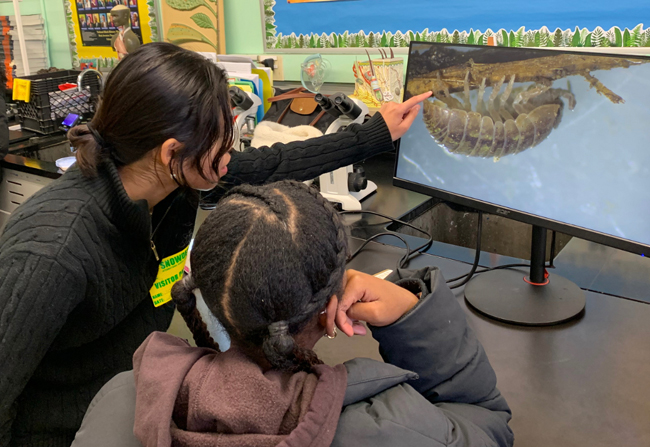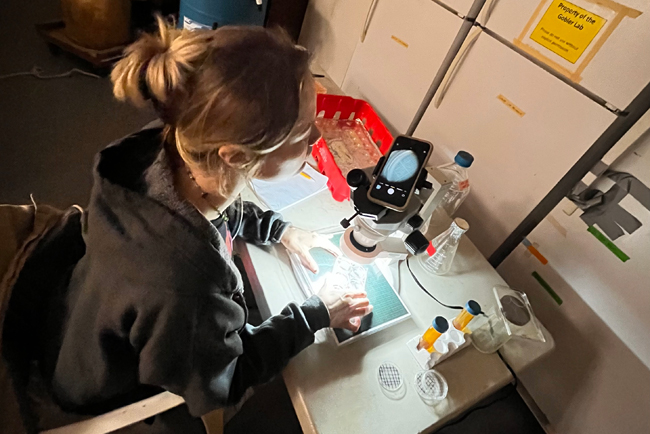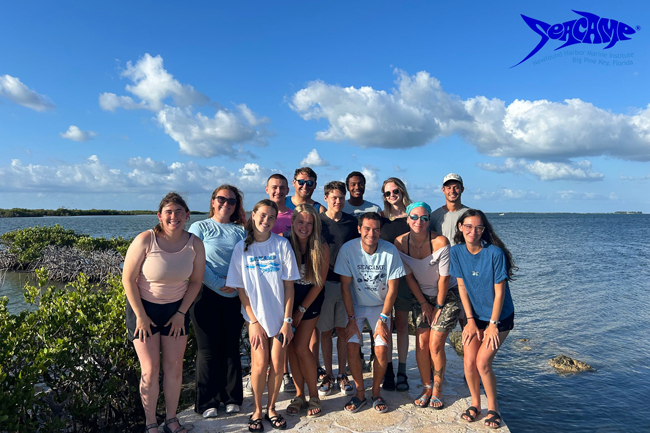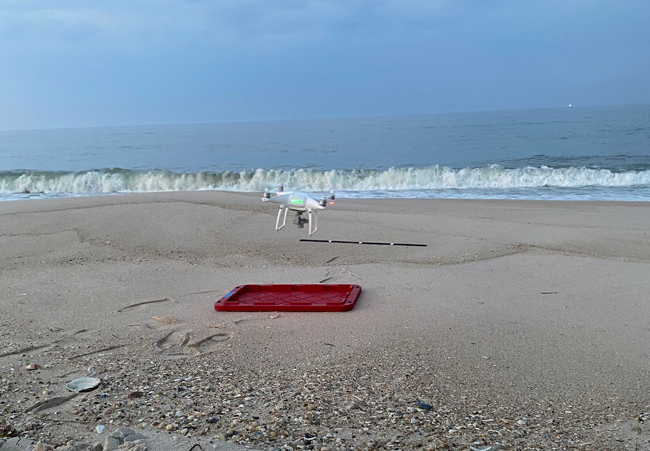— By Chris Gonzales, Freelance Science Writer, New York Sea Grant
Contact:
Kathy Bunting-Howarth, NYSG's Associate Director, E: keb264@cornell.edu, P: 607-255-2832
Ithaca, NY, December 11, 2024 - A new program is developing the next generation of research and extension professionals. Now in its fourth year, it’s called the Community Engaged Internship (CEI), and is run by New York Sea Grant (NYSG).
The CEI program has sponsored young professionals who have worked with NYSG on research and extension, supporting them as they move into the first stages of their careers. The program answers a need for professionals to take up careers in marine and coastal professions.
Each CEI fellow works with a NYSG extension mentor to plan hands-on field projects. Several young hopefuls have participated in internship experiences that have led to positions in lab research, outreach, and communications on coastal topics.
Two Professionals Who Are Making a Difference

"I work with a high school student to see what organisms we can find inside leaf litter collected from Boston Commons." — Bella Duati Credit: BioBus New England
Bella Duati
In the summer of 2021, NYSG partnered with SUNY Farmingdale State College on a project about fisheries, community science, and environmental education.
The project explored how seining is used to collect data about aquatic organisms. Seining is the use of sein nets, large rectangular nets with sinkers and floats on the corners, to catch fish and invertebrates when its ends are drawn together or pulled ashore.
The purpose of the survey was to understand the differences between the types of data collected by seining and other types of monitoring efforts.

"We are studying Daphnia (a crustacean) under the microscope and wondering if Daphnia has a brain." — Bella Duati Credit: BioBus New England
Bella Duati: In Her Own Words
Participating in the Sea Grant internship was one of the first times I felt like I could truly contribute to scientific work. While working on the Community Science through Seining project I not only learned new technical skills, but more importantly, I was excited to see how my efforts fit into larger community science goals. I connected with the other interns, even virtually.
Having Antoinette Clemetson of NYSG and Peter Park of SUNY Farmingdale State College as my mentors gave me a sense of belonging that I hadn’t always felt in scientific spaces. That sense of representation is something I carry into my work now at BioBus, where I strive to foster that same inclusivity in science for my students.
One of the most memorable days of my internship was when I participated in collecting seining data in New York City. During the pandemic, getting the chance to travel and engage in hands-on work felt refreshing. Trying out the seining method firsthand helped me understand why standardizing these practices is important for reliable data collection. This was a big moment for me, especially since it was only my third time visiting New York. Discovering the amount of nature that exists in such an urban space sparked my enthusiasm for teaching. I aim to pass that excitement on to my students in Boston, encouraging them to explore and reflect on their relationship with the environment around them. Understanding urban ecology helps them see their role in practicing environmental stewardship.
This internship continues to influence my career, focused on environmental education and science outreach. In the long term, this experience gave me the confidence to pursue bigger goals, like applying for a PhD program. Being accepted into the Sea Grant internship reinforced my belief that I belong in scientific spaces and that it’s important to create pathways for future scientists to join.

Jade Wu uses a dissecting scope in 2024 to identify hard clam larvae for the Gobler Laboratory at Stony Brook University. Credit: Jonah Florholmen-Bouman
Jade Wu
Jade worked with NYSG in the summer of 2022 and was part of the second cycle of the CEI.
As part of Jade’s work, she spent a day at the Cornell Cooperative Extension of Suffolk County's Shellfish Hatchery, observing an attempt to spawn clams that were selected to be resilient in the face of environmental stressors. She also had the opportunity to observe research being done at the Marine Animal Disease Laboratory at Stony Brook University. In the 10-week span of her project, she produced multiple communication deliverables, including a project glossary, a script for a short video, and a descriptive brochure.
The Sea Grant Hard Clam Selective Breeding Collaborative (Hub) aims to improve the aquaculture industry on the Atlantic coast by identifying naturally occurring strains of clams that are resistant to environmental stressors such as the extreme heat of Florida and a disease called QPX on the North Atlantic coast. Jade produced an introduction to this collaborative during her summer with NYSG.

All of the science instructors for the 2024 Seacamp summer camp gather on the shore. Credit: Seacamp Association, Inc.
Jade Wu: In Her Own Words
Entering university, I knew I wanted to be a part of the marine science field and this only continued to grow throughout my education. I worked with New York Sea Grant as the Communications fellow for the summer of 2022. I was able to explore my passion for writing through working with data and updating projects into usable forms for the public, which felt very rewarding. I visited a clam hatchery and marine animal diseases lab, spoke to PIs, and met graduate students in those labs.
This fellowship influenced me the most in showing me that I, too, could work in marine research. The summer thereafter I sought out research experience and I was able to assist Jessica Salmon with her thesis at the Peterson lab. For her thesis, I reviewed underwater footage and gathered data of specific fish species seen at protected areas, comparing them to non-protected areas in Jamaican waters.
Next, I worked at the Acoustic Laboratory for Ecological Studies (ALES lab) where I assisted Dean Hernadez with his thesis. I worked in the field with the DJI Phantom 4 drone and in the laboratory where I reviewed videos captured by the drone. I identified and measured fish, marine mammals, and birds, and worked with satellite imagery.
Continuing down the research path, I then got a lab technician position at the Gobler Laboratory at Stony Brook directly after receiving my bachelor’s degree. I worked mostly on water quality analysis but often assisted with various research projects within the lab.
Currently I am working on Big Pine Key at Seacamp as a science instructor and camp counselor for the summer.
I still enjoy working with research and I plan on returning to it.
Now I am gaining more experience in other marine realms while simultaneously putting myself in new environments to gain some insight on what type of research those ecosystems bring.

In 2023, this drone takes off in preparation to run its transects to identity schools of Atlantic Menhaden, a species of fish found in coastal and estuarine waters from Nova Scotia to northern Florida. Credit: Jade Wu
More Info: New York Sea Grant
Established in 1966, the National Oceanic and Atmospheric Administration (NOAA)’s National Sea Grant College Program promotes the informed stewardship of coastal resources in 34 joint federal/state university-based programs in every U.S. coastal state (marine and Great Lakes) and Puerto Rico. The Sea Grant model has also inspired similar projects in the Pacific region, Korea and Indonesia.
Since 1971, New York Sea Grant (NYSG) has represented a statewide network of integrated research, education and extension services promoting coastal community economic vitality, environmental sustainability and citizen awareness and understanding about the State’s marine and Great Lakes resources.
NYSG historically leverages on average a 3 to 6-fold return on each invested federal dollar, annually. We benefit from this, as these resources are invested in Sea Grant staff and their work in communities right here in New York.
Through NYSG’s efforts, the combined talents of university scientists and extension specialists help develop and transfer science-based information to many coastal user groups—businesses and industries, federal, state and local government decision-makers and agency managers, educators, the media and the interested public.
New York Sea Grant, one of the largest of the state Sea Grant programs, is a cooperative program of the State University of New York (SUNY) and Cornell University. The program maintains Great Lakes offices at Cornell University, SUNY Buffalo, Rochester Institute of Technology, SUNY Oswego, the Wayne County Cooperative Extension office in Newark, and in Watertown. In the State's marine waters, NYSG has offices at Stony Brook University and with Cornell Cooperative Extension of Nassau County on Long Island, in Queens, at Brooklyn College, with Cornell Cooperative Extension in NYC, in Bronx, with Cornell Cooperative Extension of Ulster County in Kingston, and with Cornell Cooperative Extension of Westchester County in Elmsford.
For updates on Sea Grant activities: www.nyseagrant.org, follow us on social media (Facebook, Twitter/X, Instagram, Bluesky, LinkedIn, and YouTube). NYSG offers a free e-list sign up via www.nyseagrant.org/nycoastlines for its flagship publication, NY Coastlines/Currents, which it publishes 2-3 times a year.